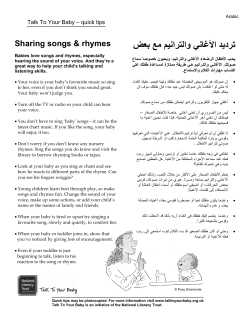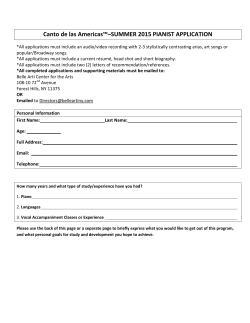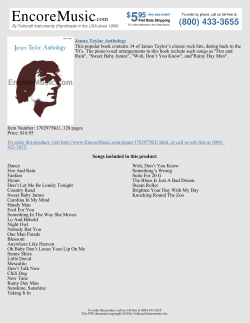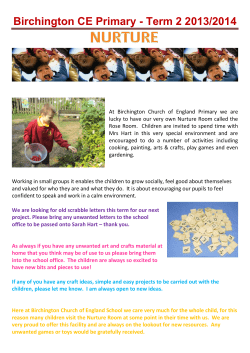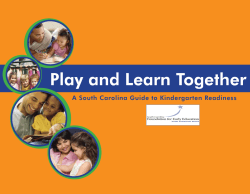
Language development Nurture your child’s language skills
Language development What could be more exciting than hearing your baby’s first word? As that first word grows into a sentence and later into conversation, you will be watching a miracle—the miracle of language development. As a parent, you are your child’s first teacher. When you take time to listen, talk, read, sing, and play games with your child, you help teach important language skills that last a lifetime. Nurture your child’s language skills Nurture your child’s language skills • When babies babble, gurgle, and coo, respond with the same sounds. • Teach babies their names and names of familiar objects. ■ Age 0 to 6 months • Waves bye-bye. Typical language skills • Responds to name. • Cries in different ways to say, “I’m hurt, wet, hungry, or lonely.” • Understands names of some familiar objects. • Makes noises to voice displeasure or satisfaction. • Pays attention to conversation. • Babbles. • Babbles expressively as if talking. • Recognizes and looks for familiar voices and sounds. • Talk with infants when you feed, dress, or play with them. • Talk to them about what you are doing: “Now I am getting Sara’s socks.” • Sing songs. • Play soft music. ■ Age 6 to 12 months Typical language skills • Shows interest in picture books. • Says first word (maybe). • Says “Da-da” and “Ma-ma” (maybe) Pm-1529f Reviewed & Reprinted January 2004 • Play peek-a-boo. • Hold babies in your lap and show them pictures in magazines and books. • Sing simple songs. ■ Age 12 to 18 months Typical language skills • Identifies family members and familiar objects. • Points to a few body parts such as nose, ears. • Follows simple, one-step instructions. • Says two or more words. • Imitates familiar noises like cars, planes, birds. • Repeats a few words. • Looks at person talking. • Says “Hi” or “Bye” if reminded. • Uses expressions like “Oh-oh.” • Asks for something by pointing or using one word. • Speak clearly and simply; “baby talk” confuses children who are learning to talk. ■ Age 18 months to 2 years Typical language skills • Says about 50 words, but can understand many more. • Echoes single words that are spoken by someone else. • Talks to self and jabbers expressively. • Says names of toys and familiar objects. ■ Age 2 to 3 years Typical language skills • Identifies up to 10 pictures in a book when objects are named. • Uses simple phrases and sentences. • Responds when called by name. • Responds to simple directions. • Starts to say plural and past tense words. • Enjoys simple stories, rhymes, and songs. • Uses two- to three-word sentences. • Uses two to three word sentences like “Daddy bye-bye,” “All gone.” • Enjoys looking at books. • Hums or tries to sing simple songs. • Repeats words spoken by someone else. • Listens to short rhymes or fingerplays. • Points to eyes, ears, or nose when asked. • Points to eyes, ears, or nose when asked. • Vocabulary expands up to 500 words. Nurture your child’s language skills • Identifies an object in a picture book. • Uses the words “Bye,” “Hi,” “Please,” and “Thank you” if prompted. Nurture your child’s language skills Nurture your child’s language skills • Teach your child names of people, body parts, and objects. • Read at least one book to your child every day. • Teach sounds that different things make. • Encourage your child to repeat short sentences. ■ Age 3 to 4 years • Read simple stories. • Give simple instructions. (“Give the book to Jon.”) • Talks so 75 to 80 percent of speech is understandable. • Read rhymes with interesting sounds, especially those accompanied by actions or pictures. • Says own first and last name. • Make a scrapbook with bright pictures of familiar objects such as people, flowers, houses, and animals to “read.” • Play word games like “This Little Piggy” or “High as a House.” • Listen, talk, and read with your child every day. • Teach your child simple songs and nursery rhymes. Typical language skills • Understands location words like over, under, on, and in. • Give children a few books of their own and show them how to take good care of them. Nurture your child’s language skills • Talks in complete sentences of 3 to 5 words: “Mommy is drinking juice.” “There’s a big dog.” ■ Age 4 to 5 years • Play games that encourage counting and color naming. Typical language skills • Stumbles over words sometimes—usually not a sign of stuttering. • Recognizes some letters if taught and may be able to print own name. • Encourage children to tell you stories. • Enjoys repeating words and sounds over and over. • Recognizes familiar words in simple books or signs (STOP sign, fast food signs). • Understands now, soon, and later. • Asks who, what, where, and why questions. • Listens attentively to short stories and books. • Likes familiar stories told without any changes in words. • Enjoys listening to stories and repeating simple rhymes. • Enjoys telling simple stories from pictures or books. • Likes to sing and can carry a simple tune. • Recognizes common everyday sounds. • Identifies common colors such as red, blue, yellow, green. Nurture your child’s language skills • Include your child in everyday conversation. Talk about what you are going to do, ask questions, listen. • Play simple games that teach concepts like over, under, on, and in. • Read books with poems, songs, and rhymes. • Encourage your children to repeat favorite stories. • Speaks in fairly complex sentences—“The baby ate the cookie before I could put it on the table.” • Enjoys singing simple songs, rhymes, and nonsense words. • Adapts language to listener’s level of understanding. To baby sister: “Daddy go bye-bye.” To mother: “Daddy went to the store.” • Learns name, address, and phone number if taught. • Asks and answers who, what, why, where, and what if questions. • Names six to eight colors and three shapes. • Follows two unrelated directions. “Put your milk on the table and get your coat on.” • Likes to talk and carries on elaborate conversations. • Likes to shock others by using “forbidden” words. • Loves to tell jokes that may not make any sense to adults. • Visit the public library regularly. • Help children create their own story books with magazine pictures or post cards. • Read books with poems and songs. • Take turns telling jokes. • Record your child telling a story or singing a song. ■ Age 5 to 6 Typical language skills • Speaks with correct grammar and word form. • Expresses self in pretend play. • Writes first name, some letters, and numbers. • Reads simple words. Nurture your child’s language skills • Read books with your child every day. • Encourage pretend play. Help children create props from old sheets, cardboard boxes, and household items. Show children how to label their creations with simple signs like “Shoe Store” or “Tickets.” You may not realize it but you probably know quite a few songs from your own childhood. Some familiar songs you might know are: If you would like to learn more songs and fingerplays check with your local library for children’s records and audio-cassette tapes. • “Hokey Pokey” ■ Read more about it! • “Farmer in the Dell” • “Mulberry Bush” • “Hush Little Baby” • “Eensy, Weensy Spider” • “If You’re Happy and You Know It” • “Old MacDonald Had a Farm” Children also delight in fingerplays like “This little piggy” and “Eensy, weensy spider.” You also might like to try the following. Can’t carry a tune? Don’t have a piano? That’s not a problem with young children. Kids love to sing! Old Owl An owl sat alone on the branch of a tree (use arm as a branch, raise thumb for owl) She was quiet as quiet as quiet could be T'was night and her eyes were wide open like this (circle eyes with fingers and look around) She looked all around; not a thing did she miss. Some little birds perched on the branch of the tree, (fingers of other hand fly on tree) And sat there as quiet as quiet could be The solemn old owl said “Whoo-whooo-whooo,” (wave hand away, fluttering fingers behind back) And jumped at the birds and away they flew. . . . and justice for all The U.S. Department of Agriculture (USDA) prohibits discrimination in all its programs and activities on the basis of race, color, national origin, gender, religion, age, disability, political beliefs, sexual orientation, and marital or family status. (Not all prohibited bases apply to all programs.) Many materials can be made available in alternative formats for ADA clients. To file a complaint of discrimination, write USDA, Office of Civil Rights, Room 326-W, Whitten Building, 14th and Independence Avenue, SW, Washington, DC 20250-9410 or call 202-720-5964. Issued in furtherance of • Encourage children to put on simple plays and shows. • Let children help you sort coupons and cut ads out of the newspaper. • Ask your child to help you locate and find grocery items in the grocery store. • Check how many store signs your child can identify when you are out running errands. ■ Try fingerplays and songs For more information about children and families, ask for the following publications from your county extension office. Understanding Children—Kindergarten Ahead, PM 1529n Understanding Children—Learning to read and write, PM 1529e Child’s Play - Fingerplays Plus, PM 1770b (cost) So Alive—Three to Five, PM 1431a–f (cost) ■ Books for Children The Listening Walk, Paul Showers The Snowman, Raymond Briggs Baby’s Favorite Things, Marsha Cohen My First Look at Colors, Stephen Oliver Gobble, Growl, Grunt, Peter Spier Push -Pull, Empty -Full, Tana Hoban Are You My Mother? P. Eastman Rosie’s Walk, Pat Hutchins Caps for Sale, Esphyr Slobodkina Written by Lesia Oesterreich, extension family life specialist. Graphic design by Valerie Dittmer King. Illustrations by Lonna Nachtigal. File: Family life 8 Cooperative Extension work, Acts of May 8 and June 30, 1914, in cooperation with the U.S. Department of Agriculture. Jack M. Payne, director, Cooperative Extension Service, Iowa State University of Science and Technology, Ames, Iowa. 2/07
© Copyright 2025
